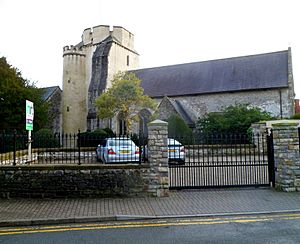Church of the Holy Cross, Cowbridge facts for kids

Church of the Holy Cross
|
|
| Lua error in Module:Location_map at line 420: attempt to index field 'wikibase' (a nil value). | |
| OS grid reference | SS 993 746 |
|---|---|
| Location | Cowbridge, Vale of Glamorgan |
| Country | Wales, United Kingdom |
| Denomination | Church in Wales |
| Website | Church of the Holy Cross |
Quick facts for kids History |
|
| Founded | 13th century |
| Architecture | |
| Heritage designation | Grade I |
| Architectural type | Church |
| Style | Medieval |
The Church of the Holy Cross is a very old church located in Cowbridge, a town in the Vale of Glamorgan, south Wales. It was built a long time ago, probably in the 1200s. This church has a unique tower design and has been repaired and updated many times over the centuries. It is considered a very important historical building in the United Kingdom.
Contents
History of the Church
The Church of the Holy Cross was likely built in the late 1200s. This was when Cowbridge was becoming a new market town. Even though it started as a smaller church for a nearby area called Llanblethian, Holy Cross was built quite large.
Changes Over Time
The church was changed and improved throughout the medieval period. This showed that the town of Cowbridge was growing and becoming richer. The first church had a tower between the main worship area (chancel) and the main seating area (nave). The tower once had a tall, pointy spire. However, lightning struck and destroyed this spire in 1480.
In the 1400s, a side section called the south Llanquian aisle was added to the nave. A north chapel was also added to the chancel. Some people believe these additions were gifts from Lady Anne Neville. She was an important noblewoman and wife of Richard, Duke of Gloucester, who later became King Richard III. The first organ in the church was a gift from Jasper Tudor. He gave similar gifts to other churches too.
Repairs and Renovations
Records from 1721 show that the tower walls were getting old. Also, the four bells in the tower were broken. The people of Cowbridge wanted eight bells instead of four. So, they used the town's money to fix the old bells and add four new ones.
In 1848, the church asked for money to replace the pews and floor. They hoped to raise £250, and much of this money came from wealthy church members. That same year, some windows in the chancel were opened again and fitted with new glass.
Between 1850 and 1852, the church had a very big renovation. This work cost £1,800 and was done by John Prichard from Cardiff. More work was done in 1893 when a gallery was removed and the tower was fixed. Further repairs happened in the 1920s and 1930s. New rails around the altar were added in 1965.
Important Building Status
The Church of the Holy Cross was officially listed as a Grade I building on May 12, 1963. This means it is a very important historical building. It was recognized as a "medieval church on a key site in a historic town centre." It also has "group value" with other important buildings nearby.
Architecture of the Church
The church is built using local limestone and white Sutton stone. These stones give the church its unique look.
The Tower
One of the most interesting parts of the church is its tower. The tower has a special design at the top. It has a corbelled wall head, which means it has stone supports sticking out. From these, angled parts slope up to an eight-sided top section with battlements (like a castle wall). Some people thought the tower was built to be a watchtower or a strong defense if the town was attacked. However, it doesn't have narrow openings for arrows (called arrow loops), which suggests it wasn't mainly for defense. On one side of the tower is a stair turret, and on the other is a large support structure called a buttress.
Inside the Church
Inside the tower, there are arches on the east and west sides. These arches are part of the original design from the 1200s. In the chancel, the only original feature is a stone basin called a piscina, made of Sutton stone.
The church has large stone supports (called piers) in a style similar to those found in the English West Country. There are also two small openings in the east wall. These were likely used for giving out alms (donations to the poor), which is a very unusual feature for a church.
Other Features
The font (where baptisms take place) is a simple eight-sided stone bowl. It tapers down to a rounded base and is believed to be from the 1300s. The stained glass windows on the eastern side of the chancel show scenes from the life of Christ. These windows were installed in 1868. The windows on the south side of the chancel show stories from the Bible that teach lessons. They were put there to remember one of the headmasters of Cowbridge Grammar School.

